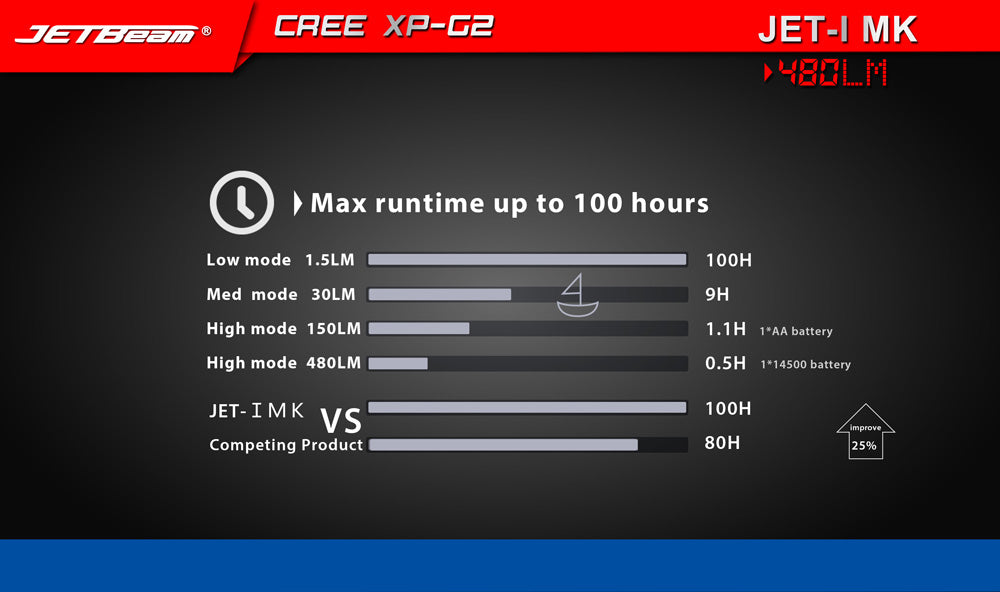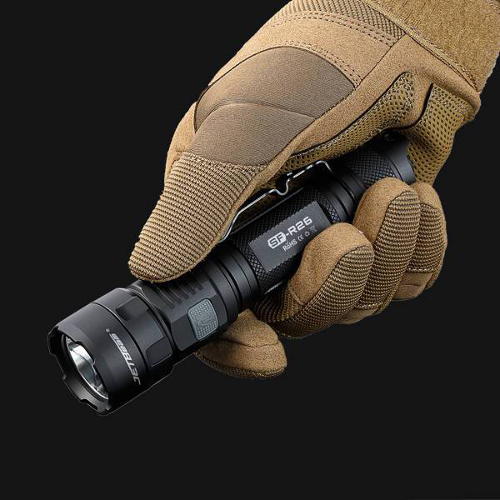
There are a few things to consider when choosing a modern handheld torch or headlamp.
- Battery type and run time
- Light output and beam distance
- Size, durability and weight
Before we look at these aspects closer, first have a think about what you need the light for? If you need a torch for search and rescue, night hiking, hunting or anything else that requires a long range beam then you'll want a bright torch with good throw and durability (1000+ lumens).
For those more recreational uses, such as camping, fishing or crawling around under your house you still want something powerful and sturdy. Anywhere from 150 to 1000 lumens should be sufficient.
General household use, indoors, around the shed and attic for shorter distance vision then you'll find a smaller torch with less features (1 - 300 lumens brightness) would do the job. So with all that in mind, let's look at batteries first.
The Power Source - Batteries
There are a number of battery sizes, chemical types and voltages to consider when it comes to modern lighting devices. Some, most of you will be familiar with, others are not so common.
For the purposes of this article, we will only look at the types of batteries used in modern LED torches and headlamps. This is the AA, the AAA CR123A RCR123A, 18650 and 17500.
Alkaline & Lithium batteries
Everyone is familiar with the D, C, AA, AAA batteries that power most torches, headlamps and lanterns. These are generally cheap, convenient, readily available (from your local supermarket for example) and they hold there charge well when not in use. However, they do not have the power output or runtime that some modern LED torches need to perform optimally. Alkaline batteries will be unreliable - reduced power and runtime – in cold weather.
Rechargeable Batteries
The best type of rechargeable batteries to use in modern LED torches and headlamps will be Li-ion (lithium-ion) batteries. They have a good runtime and they hold their charge well when not in use.
Considering the high-drain nature of the TURBO mode on most quality LED torches, it is almost a 'must' to have a rechargeable battery.
However, as a rechargeable battery needs a power source to recharge, if you are away from civilisation for an extended period, it may pay to have some back-ups of the single-use variety.
Another type of rechargeable battery is the Ni-Mh (Nickel Metal Hydride), a good option for some torches. Although these drain faster and have a shorter shelf life than Li-ion batteries, so make sure you have additional, charged back-ups.
*Always make sure you confirm what batteries your torch can accept. If you use a higher voltage lithium battery for example, in a torch not made for it, you risk damaging the circuitry.
Light output & beam distance
The brightness of a lamp is measured in lumens. A lumen is the measurement of the total amount of visible light, in other words the ‘brightness’. The higher the number of lumens the brighter the light. An average torch will output around 50 lumens, with torches capable of 4000+ lumens plus available.
Although brightness is important, another factor to consider is the 'throw' how far the beam will illuminate.
As most – if not all – modern lights use LEDs (Light Emitting Diodes), we wont look at the other types of bulbs (incandescent, halogen and xenon) and just focus on LEDs. LEDs require minimum power and are very energy efficient; which means brighter lighter for longer.
Light Output
Light output or brightness is measured in lumens (a measure of the total quantity of visible light emitted by a source). brightness output can range from a very modest 1 lumen for stealthy excursions to a blindingly bright 4000+ lumens for search and rescue type activities.
Beam Distance
Beam distance or throw is measured in metres. This is how far the light will shine before the brightness diminishes to the equivalent of the light from a full moon. Full moon illumination is considered adequate for safe and careful travel outdoors. This distance will vary with the brightness setting selected.
Run-Time
Measured in hours. How long does it take the light output to drop to 10% of the rated output on new batteries, rounded to the nearest quarter hour. Light output may gradually decrease over time, or remain largely constant and then suddenly decrease. Run time is commonly given for each light setting.
Many quality torches allow you to cycle through various modes of brightness, often with a 'turbo' mode that will give you the maximum output of the torch. Besides being brighter, this usually heats up the head of the torch and consumes battery power considerably.
Some average run times based on the 5 available brightness modes on our JETBeam SF-R26 are as follows:
Low - 10 lumens – 150 hours
Medium - 100 lumens – 13 hours
High - 250 lumens – 6 hours
Turbo/Strobe - 1200 lumens – 1.5 hours

Size, Weight & Durability
Compact size seems to be the preference these days when it comes to handheld flashlights. Although there are certainly still some larger search lights and 6D baton like beasts available, many people are looking for smaller torches they can carry in their pocket, clip on their belt or carry on their keychain.
The main housing of a torch should be strong, light, durable and if needed weather-proof. Most tactical and everyday carry torches these day are made from an aircraft grade aluminium alloy. This makes for a lightweight and strong casing. Plastic casings are still in use for lower end budget torches, and while cheaper and lighter they are also prone to damage.
Impact Resistance
Impact resistance is measured in metres. Testing of devices is done by dropping them six times onto concrete at the rated distance. Your torch will no doubt experience being dropped over its lifetime. This test is done to make sure the light still operates after an 'average' drop, say 1 to 1.5 metres. This is not a high impact or compression test such as being dropped from the top of a building or being run over by an 18 wheeled truck.
Water Resistance
Anyone outdoors – or indoors sometimes – will encounter water at some point. Whether it is light rain, a torrential downpour or a body of water, you want to know what your torch can handle. Water resistance is measured using the IPX system (International Protection Marking).
Indicates an IPX4 rating, which is splash resistant from all angles, after the impact test has been applied. Indicates a water submersion rating, also after the impact test.
IPX7 – temporary immersion: up to 30 minutes at a depth of 1m.
IPX8 – submersion: up to 4 hours at the specified depth.











2 comments
Army and Outdoors
Hi there.
You can subscribe to our newsletter but it isn’t specifically about torches. To stay up to date on them specifically, visit our collection page on torches and flashlights. https://www.armyandoutdoors.co.nz/collections/lighting-torches
Cheers,
-Army and Outdoors
Stone
Any news letters or catalogues for me to look for torches please